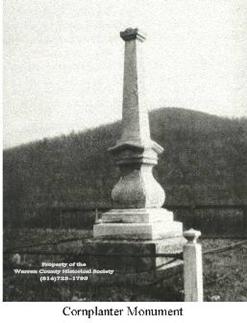
CHIEF CORNPLANTER
HISTORIC PENNSYLVANNIA LEAFLET No. 32 Commonwealth of Pennsylvania
PA Historical and Museum Commission
Harrisburg, PA 1972
“Cornplanter’s people knew him as Kaintwakon, meaning “by what one plants.” The white people knew him also as John Abeel (Obail). He was born to his Seneca Indian mother about 1750 at Ganawague, near Avon, New York. The wolf clan, to which she belonged, was a ranking Indian family. His father was John Abeel, of a prominent Albany Dutch family. Abeel had gone into the Indian country in western New York to trade and as a gunsmith. In Iroquois society the “nationality” of the mother determined that of her children. Cornplanter was reared as an Indian. Cornplanter’s family belonged to the Seneca group of the upper Allegheny River. 
During the American Revolution, the Senecas sided with the British. Cornplanter emerged from the Revolution a principal war chief of the Senecas. After the treaty of peace between Great Britain and the United States, he learned that the British, despite their promises, had neglected the interests of their Indian allies and had abandoned them to the former colonist. From that time on, he cast his lot with the United States. He helped the Whites because he regarded this as the only way to help the Indians. During 1790 and 1791, Cornplanter earned the gratitude of Pennsylvania by his heroic effort to check the development of a threatening alliance between eastern and Ohio Indians. It was at this time Cornplanter was given a land grant along the Allegheny River in northern Warren County.
On his numerous visits to New York, Albany, and Philadelphia, Cornplanter discussed religion and education with those who were concerned about his people. During his long stay in Philadelphia in the winter of 1790, he attended Quaker meetings with some regularity. The following year he asked the Quakers to accept his oldest son Henry and two other boys for schooling in Philadelphia, to which they agreed. He also asked the Society of Friends for a Seneca Mission, which was accepted in 1798. The Quakers made no attempt to convert, but instead devoted themselves to morals, education, and improved agricultural techniques. With their guidance, his community became a model, with roads, good houses, fences, plowed fields, and more cattle than could well be wintered.
After 1812, Cornplanter became disillusioned with the Americans. In remorse over his part in assimilating his people to the culture of the white man, Cornplanter burned his military uniform, broke his sword, and destroyed his medals; he closed the schools and dismissed the missionaries.
Cornplanter died at home on the Cornplanter Tract on February 18, 1836.”
IMPORTANT FACTS
*Cornplanter’s mother was a Seneca and his father was a Dutch trader.
*Cornplanter was recognized as a great warrior while helping the British fight the colonists.
*After the Revolutionary War, Cornplanter sided with the United States. He acted as a mediator between the Americans and Indian Nations.
*Cornplanter was given a tract of land on the Allegheny River in gratitude for helping the government in their dealings with the other Indian tribes.
*Cornplanter believed in the Quaker way of life and asked them to come to his land to teach the children.
*Cornplanter became disgusted with the whites and their treatment of his people and abandoned anything that he had learned and been given from them.
*Cornplanter died on the Cornplanter Grant in 1836.
Additional Resources:
Courtesy of the Warren County Historical Society